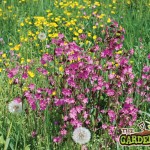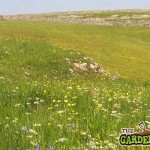If you are considering growing a wildflower meadow, there are a number of steps that you should take if you want to get it right. The key to a successful wildflower meadow is good ground preparation. To do this you will first need dry weather, dry weather and more dry weather.
- Wildflowers
- cowslips
- Grassland Meadow
The first step in creating a meadow of wildflowers is to kill of the existing weeds and grass that currently grow there. Ideally two or even three applications of weed killer would be required to kill off all that weeds that may exist on your soil. If you have a problem with scutch grass you may need to apply weed killer a fourth time.
Only once you have killed off all the weeds can you begin the second step in creating a wildflower meadow. Killing off weeds can take a long time and in the cases you could spend an entire year killing off your weeds. The reason for this is two-fold: firstly it will be the case that your soil is full of the seeds of weeds which persist in the soil for many year. The second reason is that even though a weed killer can kill or weeds it only takes a small section of it’s root to survive to lead to the growth of more weeds.
The second step in creating a wild flower meadow is to prepare the soil. This involves working it over with a rotavater to loosen the soil to encourage better seed growth. At this stage you will need to remove all big and small stones from the soil. You will only need to prepare the soil to a depth of about 6 inches so a light rotavater will do fine. When rotavating make many passes over the soil until the sods are fully broken down into fine crumbs. If there is old vegetation still on the ground at time of rotavating or the soil is damp then you will not be able to brake the soil down into a fine tilth, or fine seed bed.
If, after rotavating and you haven’t achieved a fine seed bed then you can use a harrow to brake down the larger crumbs, again you will need dry weather to do this.
Once the soil is free of weeds, roots, stones and rock and the soil has been prepared to a depth of 6 inches and has a fine crumbly texture on the surface while being relatively flat you can begin sowing your wild flower seeds.
When sowing always check the seed pack to determine the grams per m2 as this can vary from one wildflower to another while some can be as low as 1 gram per m2 which is very little and can be very difficult to measure out exactly.
Before sowing your seeds, which you will likely be spreading by hand, you should do a test run to ensure that you are not over applying your seeds to the soil.
Once sown you should lightly rake the soil and roll it to ensure good contact between the soil and seed. And now and only now you can pray for rain.


